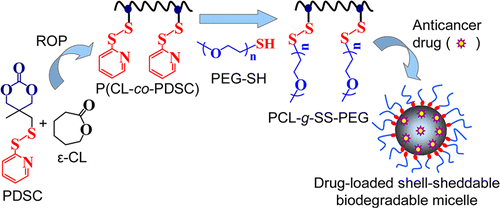Functional Poly(ε-caprolactone)s via Copolymerization of ε-Caprolactone and Pyridyl Disulfide-Containing Cyclic Carbonate: Controlled Synthesis and Facile Access to Reduction-Sensitive Biodegradable Graft Copolymer Micelles
Wei Chen †‡, Yan Zou †, Junna Jia †, Fenghua Meng †, Ru Cheng †, Chao Deng †, Jan Feijen †‡, and Zhiyuan Zhong *† (钟志远)
† Biomedical Polymers Laboratory, and Jiangsu Key Laboratory of Advanced Functional Polymer Design and Application, Department of Polymer Science and Engineering, College of Chemistry, Chemical Engineering and Materials Science, Soochow University, Suzhou, 215123, P. R. China
‡ Department of Polymer Chemistry and Biomaterials, Faculty of Science and Technology, MIRA Institute for Biomedical Technology and Technical Medicine, University of Twente, P.O. Box 217, 7500 AE Enschede, The Netherlands
Macromolecules 2013, 46, 699–707.
Pyridyl disulfide-functionalized cyclic carbonate (PDSC) monomer was obtained in four straightforward steps from 3-methyl-3-oxetanemethanol and exploited for facile preparation of functional poly(ε-caprolactone) (PCL) containing pendant pyridyl disulfide (PDS) groups via ring-opening copolymerization with ε-caprolactone. The results showed that PDS-functionalized PCL polymers were prepared with controlled molecular weights and functionalities. The exchange reaction between PDS-functionalized PCL and thiolated poly(ethylene glycol) (PEG-SH) at a PEG-SH/PDS molar ratio of 2/1 afforded PCL-g-SS-PEG graft copolymers in high yields. The dynamic light scattering (DLS) analyses showed that PCL-g-SS-PEG copolymer self-assembled into micelles with a diameter of 110–120 nm and a low polydispersity (PDI) in phosphate buffer (pH 7.4, 10 mM). PCL-g-SS-PEG micelles while sufficiently stable under physiological conditions were prone to rapid shell shedding and aggregation under a reductive condition. Doxorubicin (DOX) was loaded into PCL-g-SS-PEG micelles with a decent drug loading content of 10.1 wt %. Notably, in vitro release studies revealed that ca. 82.1% DOX was released in 12 h under a reductive environment analogous to that of the intracellular compartments such as cytosol and the cell nucleus whereas only ca. 17.5% DOX was released in 24 h under nonreductive conditions. Confocal microscopy observation indicated that DOX was delivered into the nuclei of HeLa cells following 8 h incubation with DOX-loaded PCL-g-SS-PEG micelles. MTT assays in HeLa cells demonstrated that DOX-loaded PCL-g-SS-PEG micelles retained high antitumor activity with low IC50 (half-maximal inhibitory concentration) of 0.82–0.95 μg DOX equiv/mL while blank PCL-g-SS-PEG micelles were nontoxic up to a tested concentration of 1.0 mg/mL. This study presents a versatile and controlled synthesis of PDS-functionalized biodegradable polymers and reduction-sensitive biodegradable graft copolymer micelles that are of particular interest for active intracellular drug release.

链接: http://pubs.acs.org/doi/abs/10.1021/ma302499a